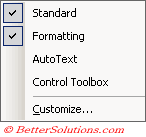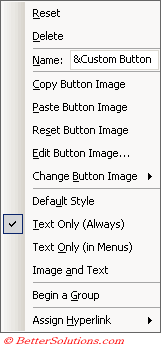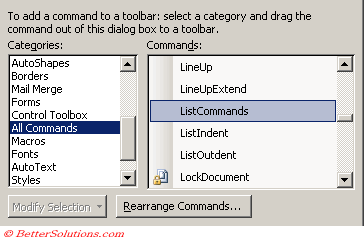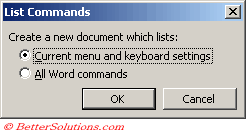Toolbars & Menus
A menu (or drop-down menu) is the way in which actions can be performed.
A toolbar is just a collection of icons that provides a shortcut to using the drop-down menu.
Toolbars offer quick shortcuts to commonly used commands.
The image that appears next to a command on a drop-down menu is usually an indication that this command also exists on a toolbar.
Word contains over fifty pre-defined toolbars and over forty pre-defined shortcut menus.
You can re-position any of the toolbars using the mouse and they can be docked to any side of the application window.
To quickly display another toolbar select (View > Toolbars) and select the toolbar from the submenu.
 |
The ticks show all the toolbars that are currently displayed on the screen.
If the toolbar you want to display is not there you, press the Customise button at the bottom and select the Toolbars tab to get a full list.
When you first open Word there are two toolbars displayed, the Standard and Formatting toolbars. These are displayed on the same row in recent version of Word although they can easily be adjusted to occupy two rows.
The commands on a drop-down menu are divided into groups. This is to help you identify and remember the commands and to associate any commands that might be related.
Can I use the Keyboard ?
You can select menu commands by using the mouse or by using the keyboard.
Pressing the Alt key will activate the Menu Bar an pressing the ESC key will deactivate the Menu Bar.
You can move between the menus by pressing the Arrow Keys or the Tab key. You can expand a particular menu by pressing the Enter key or the Up or Down Arrow keys.
Alternatively you can select a particular drop-down menu by pressing the letter that is underlined on that menu.
Once the drop-down menu has expanded you can use similar methods to select the individual commands.
Once the command is highlighted you can press the Enter key to select it.
For example you could press (Alt + "E", "S") to display the Paste Special dialog box.
You can move between the visible toolbars by pressing (Ctrl + Tab) or (Ctrl + Shift + Tab).
Are there any Menu Conventions ?
All the Microsoft Office applications have standard conventions as far as the toolbars and menus are concerned.
Icons
These are located to the left of some commands and indicate that there is a toolbar providing an alternative way to activate the command. The icon is the same as that used on the toolbar.
Shortcut keys
 |
These are located to the right of some commands and indicate that there is a alternative (and faster) way to activate the command.
Triangular Arrows
 |
These are located on the far right of some commands and indicate that there is a submenu. These are also known as Cascading menus.
Ellipsis
 |
These are located on the right of the commands and indicate that a dialog box will be displayed in order to confirm the action.
Disabled
 |
These are commands that are greyed out and indicate that the commands are unavailable at that time.
What are Screen Tips ?
These are name given to the yellow boxes that appear when you hover over command buttons.
These are extremely useful and can help identify the commands.
Docked or Floating Toolbars ?
Some of the toolbars you open are "floating" and some are "docked".
Floating toolbars can appear over the document and can be moved and dragged around.
Docked toolbars are anchored to the edge of the application window.
The different toolbars can be displayed or hidden at any time. A screen displaying fewer toolbars provides a larger and less cluttered working area.
You can move a floating toolbar by dragging its title bar. To anchor it you can double click its title bar.
To transfer a docked toolbar into a floating toolbar hover the mouse over a space in the toolbar and click and drag over the worksheet area.
When a toolbar is floating you can change its shape by dragging the borders or alternatively hide it by pressing the cross in the small cross in the top right corner.
Defining Groups on your Toolbars and Menus
Grouping commands can be useful and is easily done using the shortcut menu.
When the (Tools > Customise) dialog box is displayed you can select a command with the Right mouse button to display a Shortcut menu.
The "Begin a Group" button is a toggle and will insert a small horizontal or vertical line above or to the left of this command.
You can alternatively use the "Modify Selection" drop-down menu on the Command tab of the Customise dialog box.
 |
Adding and removing groups can also be done using the mouse although this is a little tricky.
To add a group line above a command just drag the command down (or to the left slightly).
To remove a group line just drag the command up (or to the right slightly).
Displaying Text Only or Text and an Image
The following buttons on the Shortcut menu all control how your commands appear although there are subtle differences.
 |
Default Style - This restores the default setting which is normally to display the image and text on menus but just the image on toolbars.
Text Only (Always) - The image will not be displayed when on a menu or on a toolbar.
Text Only (in Menus) - The image will not be displayed when on a menu, but will be displayed when on a toolbar.
Image and Text - The text and the image will be displayed when on a menu or on a toolbar.
(View > Full Screen)
To remove all the toolbars except the Menu bar you can select (View > Full Screen).
This will display a larger worksheet area which can often make it easier to work.
To display your toolbars after you have finished select (View > Close Full Screen).
List All Commands
It is possible to obtain a list of all the built-in commands that are available in Word.
This command is not displayed on any menu or toolbar by default but it can be added using the (Tools > Customise) dialog box.
Select the Commands tab and select "All Commands" in the list box on the left hand side.
This option will list all the commands in alphabetical order, making it easy to find the "ListCommand" commands.
 |
You can then drag this command to a menu or toolbar so it is permanently available.
Once you have included this command on to an existing menu or toolbar you can close the Customise dialog box.
Selecting this command will display the following dialog box.
 |
Current menu and keyboard settings - Creates a new document containing all the built-in menu and keyboard settings.
All Word commands - Creates a new document containing all the available built-in commands.
You can move toolbar buttons by holding down the Alt key and dragging the button to a new location.
To remove a toolbar button hold down Alt and drag the button onto the document.
Remember that the lower your screen resolution the fewer buttons you can see on a toolbar. Do all you can to maximise your screen resolution
Any changes you make to your toolbars etc ensure that they are saved in your "Normal.dot" otherwise they will not be visible every time you go into Word.
You can only add a toolbar to a template (.dot) not to a document (.doc)
You can turn this personalised menu feature off and display all the menus by selecting (Tools > Customise) (Options tab) uncheck the "Menus show Recently Used Commands" checkbox.
Words interface for manipulating built-in shortcut menus is slightly nicer than in Excel, although you can't manually add a shortcut menu and you can't modify a custom toolbar ??
If you have an addition drop-down menu at the top however the buttons do not actually do anything then you need to reset your Menu Bar in Normal.dot close Word and open up again.
There is a big difference between the "FileNew" and the "FileNew..." command
To obtain a list of all commands used by Word, (Tools > Macro > Macros). In the macros in box, select "Word Commands". In the list choose List Commands and press Run. It displays commands shortcut keys and the menu they are available from
Important
Be aware that toolbars will overlap when there is not enough room on the screen.
Word's new personalised menus only show commands you frequently use.
You can close a toolbar by clicking on the tiny cross in the top right corner. This is only available when the toolbar is floating.
It is possible to make your toolbars and buttons larger by using the "Options" tab of the (Tools > Customise) dialog box. This can be done by checking the "Large Icons" check box.
To quickly display a toolbar, press the Right mouse button when over a menu or toolbar to display the (View > Toolbars) list.
© 2025 Better Solutions Limited. All Rights Reserved. © 2025 Better Solutions Limited TopPrevNext